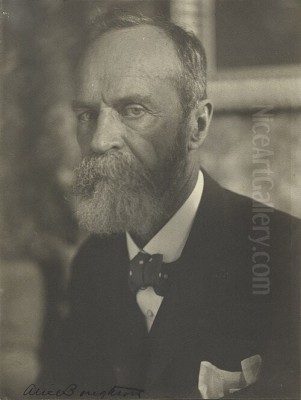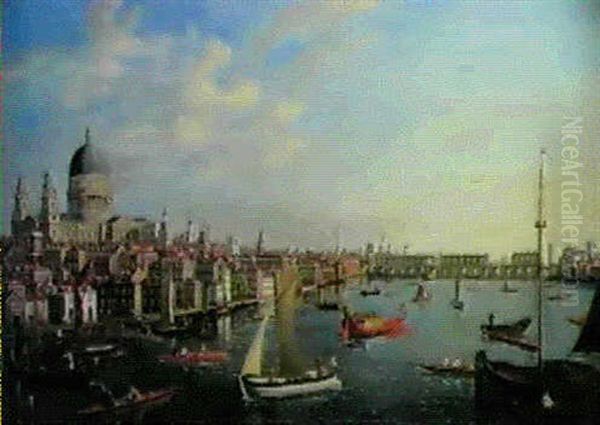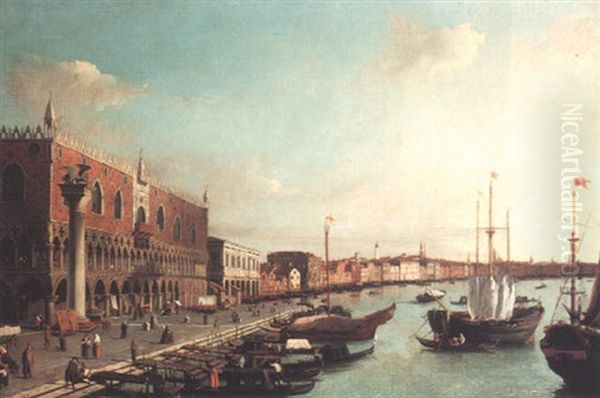
William James stands as a figure representative of a particular moment in British art history, specifically the mid-eighteenth century London art scene. Active primarily as a landscape and topographical painter between approximately 1754 and 1771, James is perhaps best known today not for a vast and celebrated body of work, but for his close association with the renowned Venetian view-painter, Antonio Canaletto, during the latter's extended stay in England. While details of his life remain frustratingly scarce, his exhibition record and the nature of his attributed works place him firmly within the burgeoning tradition of depicting the urban landscape of London, a genre significantly boosted by Canaletto's presence. Understanding William James requires looking not only at the few facts known about him but also at the vibrant and evolving artistic environment in which he operated.
The London Art World in the Mid-Eighteenth Century
The London that William James inhabited as a painter was a city undergoing significant transformation, both physically and culturally. It was solidifying its position as a major European capital and a hub of commerce, empire, and intellectual life. This dynamism was reflected in its art world, which, while perhaps not yet possessing the established state-sponsored infrastructure of Paris, was energetic and increasingly diverse. Before the founding of the Royal Academy of Arts in 1768, London lacked a single, dominant institution for artistic training and exhibition.
Artists relied on a network of patronage, ranging from the aristocracy to the rapidly expanding merchant and professional classes. Coffee houses, print shops, and auction rooms served as informal meeting places and points of sale. Early attempts at collective organisation and exhibition included the Society of Artists of Great Britain, founded in 1761, and the Free Society of Artists. These societies provided crucial platforms for artists like James to showcase their work to the public and potential buyers, playing a vital role in fostering a sense of professional identity and community among artists. The taste for landscape and topographical views was growing, fuelled by national pride, the Grand Tour phenomenon (even if experienced vicariously through art), and a desire among property owners and city merchants to see their environment recorded.
Canaletto's London Sojourn and its Impact

A pivotal event for London's art scene, and directly relevant to William James, was the arrival of Giovanni Antonio Canal, known as Canaletto, around 1746. The celebrated Venetian master, famed for his sparkling, detailed views (vedute) of Venice, sought new markets when the War of the Austrian Succession disrupted the flow of British Grand Tourists to his native city. He remained in England for the better part of a decade, until about 1755 or 1756.
Canaletto's impact was immediate and profound. English patrons, already familiar with his Venetian scenes, eagerly commissioned views of their own capital and country estates. He painted numerous iconic prospects of the Thames, Whitehall, Westminster Bridge, St. Paul's Cathedral, and various Northumberland estates, applying his characteristic style: bright, clear light, meticulous architectural detail, precise perspective, and lively depictions of daily life. His work set a new standard for topographical painting in England and significantly boosted its popularity and prestige. His presence provided direct inspiration and, for some like William James, potential tutelage.
The Connection: James as Pupil or Assistant
The most frequently cited biographical detail about William James comes from Edward Edwards's Anecdotes of Painters (1808). Edwards, himself a painter and associate of the Royal Academy, recorded that James had been a pupil or assistant to Canaletto during the Italian master's time in London. While the exact nature of this relationship remains unconfirmed – whether formal apprenticeship or looser studio assistance – the influence is undeniable in James's subsequent work.
This association likely provided James with invaluable training in Canaletto's techniques, particularly his methods for achieving accurate perspective, handling architectural detail, and composing complex urban scenes. It placed James directly within the orbit of the most fashionable topographical painter of the day, potentially opening doors to patrons seeking similar views. However, Edwards also offered a somewhat critical assessment, suggesting that James, while competent, primarily imitated Canaletto's manner without consistently matching his quality or originality. This judgment has coloured perceptions of James ever since.
The Influence of Samuel Scott
While Canaletto is the most prominent name linked to William James, another significant contemporary influence was Samuel Scott. Often dubbed the "English Canaletto," Scott was a leading marine and topographical painter in London, active from the 1720s until his death in 1772. He too fell under Canaletto's spell, adapting his own style to incorporate the Venetian's brighter palette and more detailed approach, particularly in his celebrated views of the Thames and Covent Garden.

However, Scott retained a distinct character in his work, often displaying a softer, more atmospheric handling of light and water than Canaletto, perhaps reflecting a more inherently English sensibility. Given that James painted similar London subjects, particularly Thames views, it is highly probable that he was also influenced by Scott, who was a major figure in the London art world throughout James's active period. James's style likely represents a blend of influences, drawing on Canaletto's structural precision and Scott's familiarity with the specific light and life of the London riverside. Other marine painters like Charles Brooking, though dying young in 1759, also contributed to the popularity of river and sea scenes.
Topographical Painting Takes Hold
The genre in which William James primarily worked – topographical view painting – was experiencing a surge in popularity in mid-eighteenth-century Britain. These paintings offered detailed and recognizable depictions of specific locations, appealing to a sense of place, civic pride, and the interests of landowners. London, as the rapidly growing capital and centre of national life, was a particularly favoured subject.
Artists like James catered to a market eager for images of familiar landmarks, new engineering marvels like Westminster Bridge (completed 1750), and the bustling activity of the River Thames. These works served not only as decoration but also as records of the changing urban environment. The demand was further stimulated by the burgeoning print market, which disseminated topographical views to a wider audience. James's focus on London views places him alongside artists like Samuel Scott, William Marlow (a younger contemporary also influenced by Canaletto and Scott), and, in watercolour, the brothers Paul Sandby and Thomas Sandby, who were instrumental in raising the status of topographical art.
James's Exhibited Works and Artistic Style
Directly attributing surviving paintings to William James can be challenging, as is common with less documented artists of the period. However, his exhibition record provides valuable clues about his subjects and output. He exhibited regularly, first with the Society of Artists of Great Britain at Spring Gardens between 1761 and 1768, and subsequently at the newly formed Royal Academy of Arts from 1769 to 1771.
His exhibited titles confirm his focus on London views: "A View of Westminster Bridge from the Surrey side," "A View of London Bridge," "A View on the Thames at Lambeth," and similar subjects appear frequently. He also exhibited views taken from Richmond Hill, a popular vantage point. Intriguingly, he also showed Venetian scenes, such as "A View of the Grand Canal at Venice." Given the lack of evidence that James ever travelled to Italy, these were almost certainly adaptations or copies derived from Canaletto's compositions, further highlighting his debt to the master.
Based on his influences and exhibited subjects, James's style likely involved careful delineation of architecture, attention to perspective, and the inclusion of numerous small figures and boats to animate the scene, characteristics learned from Canaletto. His handling might have been somewhat drier and less luminous than Canaletto's best work, perhaps closer in some respects to the manner of Samuel Scott or William Marlow. The variable quality noted by Edwards might suggest inconsistency or perhaps the involvement of studio assistants in producing replicas or versions of popular views, a common practice at the time.
Exhibiting at the Society of Artists and the Royal Academy
James's participation in the major London exhibitions underscores his professional activity during the 1760s. The Society of Artists of Great Britain, where he exhibited initially, was the most important exhibiting body in London before the Royal Academy's establishment. Its annual shows were significant cultural events, attracting large crowds and critical attention. Exhibiting here allowed James to compete for attention alongside established figures like the landscape painter Richard Wilson and, in his earlier years, Thomas Gainsborough, as well as prominent portraitists and history painters like Francis Hayman.
His move to exhibit at the Royal Academy from its second exhibition in 1769 until 1771 indicates his alignment with the new, prestigious institution founded under the patronage of King George III. The RA aimed to raise the status of art and artists in Britain, providing training through its schools and a prominent annual exhibition venue at Pall Mall, later at Somerset House. Exhibiting alongside founding members like the President Sir Joshua Reynolds, Gainsborough (though his relationship with the RA was complex), the landscape painter George Barret, the animal painter Sawrey Gilpin, and the marine specialist Dominic Serres placed James within the mainstream of the London art establishment during these years. His addresses listed in the catalogues – first near Maiden Lane, later in May's Buildings, St Martin's Lane – place him geographically in the heart of London's artistic community.
Contemporaries and the Wider Artistic Context
To fully appreciate William James's position, it's helpful to consider the broader artistic landscape of the 1760s. While James focused on topographical views, other genres flourished. Portraiture reigned supreme, dominated by Joshua Reynolds and Thomas Gainsborough, whose styles defined the era. History painting, considered the highest genre, was promoted by the RA, with practitioners like Benjamin West (though arriving slightly later) and Angelica Kauffman gaining prominence.
In landscape painting, Richard Wilson was forging a new path, adapting the classical, idealized landscapes of Claude Lorrain to British scenery, a contrast to James's specific topographical approach. Gainsborough, though primarily a portraitist by this time, had produced exquisite, naturalistic landscapes earlier in his career. Animal painting was reaching new heights with George Stubbs, whose anatomical precision and sensitive portrayals were unparalleled. Joseph Wright of Derby was exploring dramatic effects of light, often depicting scientific and industrial subjects, offering a very different view of modern life compared to James's London scenes. Johann Zoffany captured theatrical scenes and intimate 'conversation piece' portraits. This rich tapestry highlights the specific niche occupied by James and the Canaletto-Scott school of topographical painting within a diverse and competitive art world.
Later Years and Historical Obscurity
Information about William James effectively ceases after his last recorded exhibition at the Royal Academy in 1771. His date of death, his activities in later life, and the reasons for his disappearance from the exhibition records remain unknown. This lack of information contributes significantly to his relative obscurity compared to his primary influences, Canaletto and Scott, or major contemporaries like Reynolds, Gainsborough, and Wilson.
Several factors likely contribute to this obscurity. He may have died relatively young, or perhaps ceased painting professionally. His work, while competent, may have been perceived by later generations as too derivative of Canaletto, lacking the originality or distinct national flavour found in Wilson or Gainsborough. Topographical painting, while popular, was often ranked lower in the academic hierarchy of genres than history painting or portraiture. Furthermore, the sheer volume of London views produced by Canaletto, Scott, Marlow, and others may have overshadowed his contribution. Many works from this period have lost their original attributions, and paintings by James may now be misattributed to Scott, Marlow, or simply labelled "Follower of Canaletto." Edward Edwards's brief and somewhat dismissive account in his Anecdotes likely also played a role in cementing James's status as a secondary figure.
Conclusion: A Competent Painter in a Defining Era
William James remains a somewhat enigmatic figure in the history of British art. Active during a crucial period of development for the London art world and the genre of topographical painting, his career was significantly shaped by the towering presence of Canaletto. As a pupil or assistant, he absorbed the Venetian master's techniques and applied them primarily to views of his native London, contributing to the popular demand for such images. His regular exhibition record at the Society of Artists and the Royal Academy confirms his professional standing in the 1760s.
While perhaps lacking the innovative genius of some contemporaries and overshadowed by his famous mentor, James represents an important aspect of mid-eighteenth-century British art: the assimilation of prestigious foreign influence (Canaletto) blended with native traditions (represented by figures like Samuel Scott) to meet a growing domestic market for landscape and cityscape views. His work, though often difficult to identify securely today, forms part of the visual record of London at a time of significant growth and change. He stands as a testament to the skilled practitioners who operated within the orbit of major masters, contributing to the richness and variety of the artistic scene, even if history has relegated them to the footnotes rather than the main text. Studying William James offers a glimpse into the everyday workings of the London art world and the pervasive influence of one of painting's great view-makers.